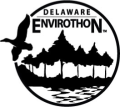Go to Wildlife Practice Tests, Exercise, and Sample Questions
Training Resources for Wildlife
Diverse wildlife populations are valuable from many standpoints, as indicators of a healthy ecosystem, for recreation, and for aesthetics. Understanding a species; requirements and habits is the first step in ensuring the continuing existence of that particular animal. Proper protection and management of an animal’s habitat will encourage optimum populations.
ENVIROTHON students will be able to:
- Identify common wildlife species from mounted specimens, silhouettes, or pictures (Part of an animal may be shown instead of the whole animal.) Keys will be used for more extensive identification
- Identify common wildlife species based on wildlife sign. Sign can include animal fur, hair, feathers, gnawings, rubbings, pellets, and scat
- Answer questions concerning the natural history of wildlife species occurring in Delaware
- Identify wildlife species from natural history information
- Identify basic wildlife survival needs
- Describe specific adaptations of wildlife to their environment and role in the ecosystem
- Describe food chains and food webs and be able to identify examples
- Describe predator/prey relationships and be able to identify examples
- Describe factors that limit or enhance population growth
- Identify habitat requirement for specific species
- Evaluate a given habitat and select or list species most likely to live there
- Describe ways habitat can be improved for specific species by knowing their requirements
- Discuss concepts of carrying capacity and limiting factors
- Answer questions concerning hunting regulations and how they pertain to wildlife management
- Describe various ways people can help in the protection, conservation, management, and enhancement of wildlife populations
- Identify agencies responsible for providing the protection and management of wildlife resources
- Identify wildlife species that are listed as endangered or threatened and describe the main causes that have led to the depleted populations
- Describe major consequences of wetland destruction on wildlife
- Identify non-native wildlife species that have been introduced into Delaware accidentally and purposely
- Know the cause, symptoms, species affected and management/monitoring methods for the following wildlife diseases: Rabies, White-nose Syndrome, Epizootic Hemorrhagic Disease (EHD), Chronic Wasting Disease (CWD)
